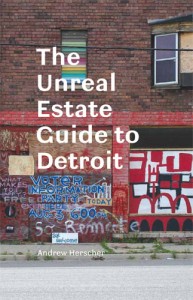
A new book by UM professor Andrew Herscher details the changes taking place in Detriot. Photo: Andrew Herscher
By Eric Freedman
The vision of Detroit that Andrew Herscher presents isn’t the glitz of the Renaissance Center, the renovation of the Cobo Center or new townhouses with Detroit River views. Nor is it the proliferation of burned-out crack houses, abandoned cars or graffiti-marred overpasses.
Instead, the University of Michigan architecture professor offers community gardens flourishing in empty lots, artists using fire-damaged buildings as palettes for creative projects and neighborhood fairs in the city’s alleys.
Herscher recasts what’s often characterized as a “shrinking city” — shrinking population, shrinking places to shop, shrinking jobs, shrinking economic prospects — and portrays Detroit as a venue for “new understandings of the city’s spatial and cultural possibilities.”
Opportunities come from what he labels “unreal estate,” meaning “urban territory that has fallen out of the literal economy, the economy of the market, and thereby become available to different systems of value, whether cultural, social, political or otherwise.”
One such endeavor on the Eastside, the 27-year-old Heidelberg Project, is well-known as a self-described “outdoor community art environment” that relies on recycled and found materials.
But there is far more grassroots, future-looking activity going on across the city, according to Herscher’s new book, the “Unreal Estate Guide to Detroit” (University of Michigan Press, $29.95),
Thus a community group harvesting wild blackberries and mulberries on public and abandoned property, then trading the fruit for products or services. Thus collective farms on Farnsworth Street. Thus the African Bead Museum on the near Westside, the Tashmoo Biergarten in West Village and the Car Wash Café at the corner of Meldrum Street and East Jefferson Avenue.
Herscher wrote, “Detroit is frequently framed as a city in need: of investment, infrastructural improvement, good governance and many other things besides.
“Needs create spaces and opportunities for alternative means of achieving viable urban lives,” he said.
Thus the adaptive reuse of architecturally significant structures, such as preservation of the historic exterior of the 1925 Michigan Theatre when the building was converted to a parking garage. Thus the cadre of volunteers known as the Navin Field Ground Crew who weed, mow and maintain what was the site of Tiger Stadium.
More challenges arise even as neighborhood residents and newcomers innovate and adapt.
For example, a plan by the Detroit Free Press and Detroit News to move from their 96-year-old building on West Lafayette Boulevard raises questions about the fate of the historic structure designed by noted architect Albert Kahn. In addition, the former Free Press building several blocks away remains empty.
The Detroit Newspaper Partnership, the business arm of the two daily newspapers, hasn’t announced a new location but said the company will stay in the city.
Meanwhile, city government is pursuing more traditional strategies to deal with “shrinking city” problems.
For example, it’s expanding its “White Picket Fence Program” to the North End, where property owners will be able to buy adjacent city-owned lots for $200. It began in Southwest Detroit.
Participants get a $200 gift card to buy fencing supplies and beautify the property.
“The program provides residents with an immediate tool to reduce blight in our neighborhoods, and the fenced lots tend to deter illegal dumping,” Mayor David Bing said.
The city also aims to demolish 10,000 dangerous abandoned homes by the end of this year, with more than 6,000 already torn down.
Each year, the City of Detroit spends millions of dollars tearing down thousands of houses–many of which could be restored, lived in, and kept on the tax rolls. It’s no wonder that Detroit’s tax base keeps shrinking each year.